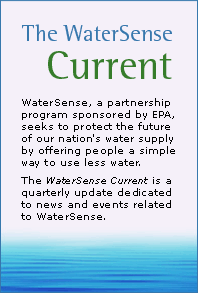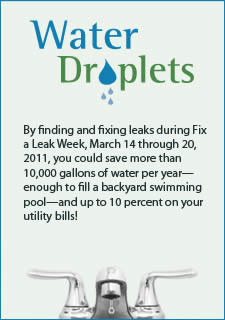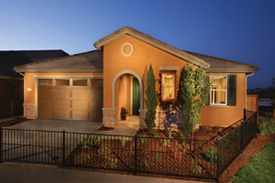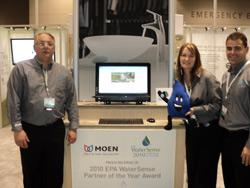The WaterSense Current Winter 2011
In This Issue XVII, Winter 2011:
 |
In This Issue: |
The Tapped 10

Could we tap out tap water? Ten major cities in the United States might just do that sooner than you think. Based on recent reports from the National Resources Defense Council (NRDC) and the environmental research group CERES, financial news outlet 24/7 Wall St. put together a list of metropolises most at risk for water shortages![]() . The 10 largest cities by population most likely to face water shortages in the near future are Los Angeles, Houston, Phoenix, San Antonio, the San Francisco Bay Area, Fort Worth, Las Vegas, Tucson, Atlanta, and Orlando.
. The 10 largest cities by population most likely to face water shortages in the near future are Los Angeles, Houston, Phoenix, San Antonio, the San Francisco Bay Area, Fort Worth, Las Vegas, Tucson, Atlanta, and Orlando.
Fortunately, many of these at-risk cities are already taking steps to reduce water use. For example, water utilities in these cities and many surrounding suburbs are WaterSense partners. That means that the major water providers are committed to working with customers to use water efficiently and manage supplies for the public benefit.
These utilities aren't the only stakeholders helping to protect water for future generations. They are joined by many other local WaterSense partners:
| The Tapped 10 Cities | |
|---|---|
| City | Number of WaterSense Partners in the city |
| 1. Los Angeles, California | 7 |
| 2. Houston, Texas | 11 |
| 3. Phoenix, Arizona | 19 |
| 4. San Antonio, Texas | 3 |
| 5. San Francisco Bay Area, California | 5 |
| 6. Fort Worth, Texas | 4 |
| 7. Las Vegas, Nevada | 14 |
| 8. Tucson, Arizona | 14 |
| 9. Atlanta, Georgia | 10 |
| 10. Orlando, Florida | 6 |
- Local and state governments, home builder associations, and other stakeholders that promote WaterSense and water efficiency to residents.
- Manufacturers that bring WaterSense labeled fixtures to the market by manufacturing more than 3,000 different models of WaterSense labeled fixtures, including toilets, bathroom faucets, showerheads, and flushing urinals.
- Retailers and distributors that help customers find and understand the value of WaterSense labeled products.
- Builders who construct water-efficient new homes to the WaterSense specification.
- Certified irrigation professionals who can help design, install, and/or audit irrigation systems for maximum water efficiency.
Saving water isn't only a job for WaterSense partners. We all can play a role by using water wisely at home and by fixing leaks, both of which were identified as key water-saving strategies in the NRDC and CERES reports. For tips and hints on how to save water, visit WaterSense's What You Can Do page and watch out for Fix a Leak Week, WaterSense's national campaign to help homeowners find and fix household leaks.
Beat the Leak: Check. Twist. Replace.


Drip. Drip. Drip. That sound adds up to more than 10,000 gallons of water wasted in the average home each year due to easy-to-fix leaks. Nationwide, household leaks add up to more than 1 trillion gallons lost each year.
As part of EPA's We're for Water campaign, Fix a Leak Week—March 14 through 20, 2011—encourages American households to stop leaks and begin saving enough water each year to fill a backyard swimming pool.
Start saving water today with three simple steps: check, twist, replace.
- Check your home for leaks. You can detect silent toilet leaks, a common water-wasting culprit, by adding food coloring to the toilet tank and waiting 10 minutes before flushing. If color appears in the bowl, your toilet has a leak. Visit Fix a Leak Week for do-it-yourself toilet repair tips and videos.
- Twist and tighten fixture connections with a wrench or apply pipe tape to ensure that fixture connections are sealed tight. If you can't stop those drops yourself, contact a plumbing professional. For additional savings, twist WaterSense labeled aerators onto bathroom faucets to use 30 percent less water without noticing a difference in flow.
- Replace the fixture. If you just can't nip that drip, it may be time to replace the fixture. Look for the WaterSense label, which indicates that a fixture uses at least 20 percent less water and was independently certified to perform as well as or better than standard models. For example, replacing your home's old, inefficient showerheads with WaterSense labeled models lets you shower with power while shrinking your household's water footprint by 2,300 gallons annually and saving enough energy to run a television all year long.
Follow WaterSense on Twitter![]() and "like" us on Facebook
and "like" us on Facebook![]() for up-to-date information about Fix a Leak Week and water-saving tips. To learn more about Fix a Leak Week, visit www.epa.gov/fixaleak.
for up-to-date information about Fix a Leak Week and water-saving tips. To learn more about Fix a Leak Week, visit www.epa.gov/fixaleak.
KB Home Brings Water and Energy Savings Under One Roof

KB Home![]() , a Fortune 500 builder with residential developments from California to South Carolina, recently cut the ribbon—and water and energy use—on the first residences certified to earn a label under the WaterSense new homes program.
, a Fortune 500 builder with residential developments from California to South Carolina, recently cut the ribbon—and water and energy use—on the first residences certified to earn a label under the WaterSense new homes program.
The Los Angeles-based company already builds all of its homes in new communities to qualify for the ENERGY STAR® label for new homes. Since teaming up with WaterSense earlier this year, KB has also committed to building homes to earn the WaterSense label. KB homes near Sacramento in Roseville, California, and in Orlando, Florida, are the first in the nation to meet the 2009 WaterSense Specification for Single-Family New Homes, which provides a blueprint for homes that use 20 percent less water than a typical new home and save at least $100 annually on utility bills.
"Owning a WaterSense labeled house means you can enjoy all the comforts of home while using fewer natural resources and saving money," said Veronica Blette, chief of EPA's WaterSense branch. "A family investing in a WaterSense labeled new home will save enough water each year to wash more than six months' worth of laundry and enough energy to power a television for four years."
"Our homes include WaterSense labeled plumbing products, water-efficient fixtures and landscape design, and a hot water delivery system that reduces the amount of time and energy needed to heat water in a home," said Jeffrey Mezger, KB Home's president and chief executive officer. "KB Home is proud to offer this new money-saving technology at no cost to our homeowners in Roseville and Orlando and will shortly be announcing the expansion of this program to Austin, Texas."
Each WaterSense labeled new home is independently inspected and certified by a licensed certification provider to ensure it meets EPA's efficiency and performance criteria. EPA estimates that if the approximately 500,000 new homes built last year had met WaterSense criteria, they would be saving Americans 5 billion gallons of water and more than $50 million in utility bills annually.
Learn more about WaterSense labeled new homes.
Moen Goes "All In" with WaterSense Labeled Products

Whenever one of plumbing manufacturer Moen Incorporated's new bathroom faucets is used, it will be saving water—though users probably won't be able to tell the difference. That's because Moen earned the WaterSense label for 100 percent of its bathroom faucet models in 2009, ensuring they use 30 percent less water while performing just as well as standard models. This is one of many reasons why Moen was named 2010 WaterSense Manufacturer Partner of the Year.
In addition to earning the label for all new bathroom faucet models in 2009, Moen also qualified the existing faucet models in its multi-family brand and luxury brand to earn the WaterSense label.
"We wanted to show our commitment to doing the right thing for both the environment and our customers," said Tom Liebhardt, Moen's senior director of marketing. "This transition was the most impactful action we could think of to fuel water conservation without sacrificing user experience."
Moen was also honored for helping to spread the word about WaterSense labeled products. Moen spokespersons promoted WaterSense on the Today show, The Money Pit—a home improvement radio show with more than 25 million listeners—and in publications such as Good Housekeeping, Elle Décor, and Fine Homebuilding. Moen also hosts an online forum for builders and remodelers and has included the importance of water efficiency and WaterSense labeled products as discussion topics.
Moen also practices what it preaches. In 2009, the company began reusing 70 percent of the water used in product testing and educating employees about WaterSense.
"Being named WaterSense Manufacturer Partner of the Year confirms that our efforts to provide water-efficient products and promote water-saving practices to-date have been successful," said Liebhardt. "But we cannot stop there —we must constantly encourage, promote, and demonstrate water-saving practices."
Learn more about Moen![]() .
.
In the Pipeline: Water Softeners
Hard water can decrease a soap's cleaning abilities, cause scale build-up in pipes, and lead to soap scum and hard water spots. For this reason, many households use water softeners, which can double the life of linens, reduce laundry soap consumption, and shorten washing times.
But the process of removing the calcium and magnesium ions found in hard water and exchanging them with sodium (or potassium) ions may be responsible for using more than 25 gallons of water each day per softener—that's up to 10,000 gallons per year!
With recent improvements in water softening technology reducing this water consumption and demonstrating potential for water savings, WaterSense released a notification of intent (PDF) (8 pp, 56KB, About PDF) to study cation exchange water softeners to potentially earn the WaterSense label. After gathering input from interested stakeholders, WaterSense will begin looking into a draft specification for water softeners that use less water while still performing well.
WaterSense is encouraging all interested parties to provide input on any of the issues presented in the notification of intent. Send your comments or suggestions on the cation exchange water softener specification development process to us at watersense-products@erg.com.
Learn more about what's in the pipeline for water softeners.




